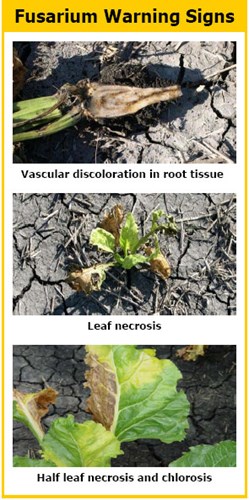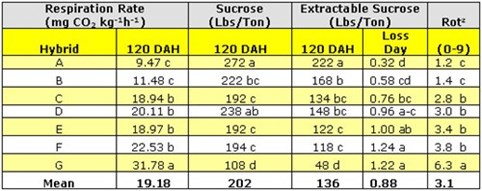537 - Root Disease Management: Fusarium
Fusarium was first identified about 20 years ago in the Red River Valley. At that time the disease was a novelty and caused no economic loss to sugarbeet producers. The disease increased in incidence throughout the 1990's. Disease severity increased to the point of causing economic losses early this century. Yield loss has become so severe that fields have had to be abandoned in each of the last four years. Storage losses of sugar are very severe with Fusarium infected roots in piles. Fusarium can affect the crop from right after emergence up until harvest.
Fusarium Symptoms

Seedling Stage
Fusarium will exhibit symptoms on seedlings as early as the 2-4 leaf stage of growth. Seedlings may initially show a yellow - green leaf mottling effect. As disease gets more severe leaves become chlorotic, with leaf margin or whole leaf necrosis. In severe situations up to 50% stand loss may occur
Mature Root Symptoms
First observed symptoms in July, August and September maybe canopy wilting due to inability of the plant to efficiently transport water from roots to leaves. A cross section of the root will have distinct discoloration of the vascular rings. The discoloration may be dark grey to a rusty orange color. As disease severity progresses through the summer the leaf canopy will exhibit severe chlorosis or necrosis. Typical leaf symptoms exhibit discoloration, chlorosis or necrosis on only one half of the leaf. Roots may exhibit a tip rot that can be confused with Aphanomyces.
About Fusarium
- Fusarium is caused by a soil borne fungus
- It is spread by any means of infected soil transport from field to field
- Over-winters in soil and can survive for long periods of time.
- Hot conditions during summer increase disease severity
- Severely effected plants seldom recover
- Redroot pigweed may be an alternate host for some species
Economic Impact
Yield loss can range from 5-50 percent. Fields with severe seedling disease may have to be replanted. Fields with more than 50% of the roots infected are considered unfit for long term storage. They must be harvested during prepile or completely abandoned.
Geographic Distribution
Clay County has the most severe yield loss from Fusarium. Norman County has the second greatest incidence and severity of Fusarium. The disease has also been documented in Wilkin, Grand Forks, Polk, Walsh and Pembina counties. It's likely all counties have at least a low incidence of the disease.
Sugar Losses in Storage
Table 1. Respiration rate 120 days after harvest (DAH), sucrose and extractable sucrose concentration, daily sucrose loss during storage, and rot rating of seven adapted commercial sugar beet hybrids, Moorhead, MN 2004w. Campbell and Fugate, USDA

w Means within a column followed by the same letter are not significantly different (P = 0.10)
xDAH = days after harvest (29 September 2004).
z Rot rating 0 = no rot 9 = completely rotted
Fusarium Control Measures
- Choose resistant varieties
- No cost effective chemical control
- Lengthen crop rotations
- Early planting
- Control of weed hosts
- Good drainage
- Proper fertility

